TAKHT
- E - SOLEYMAN
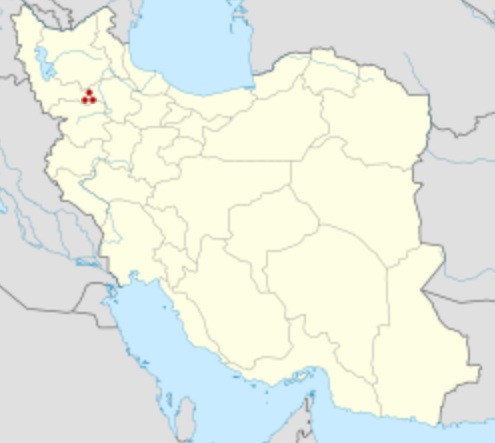
Takht
- E - Soleyman
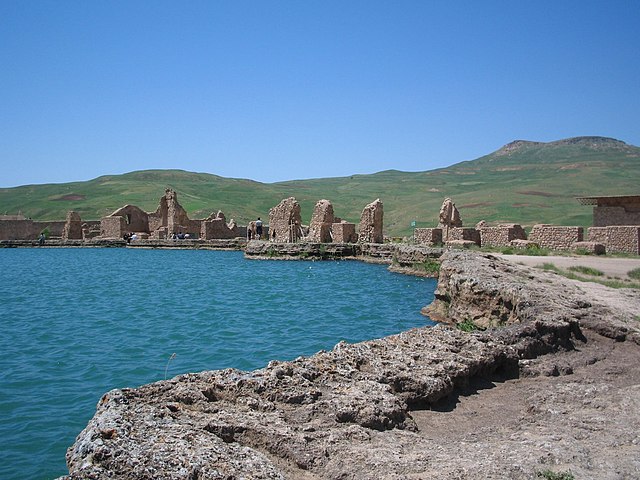
The
crater at Takht-e Soleyman
Location
: West Azarbaijan, Iran
Coordinates : 36.603171° N 47.235949° E
Type : Settlement
UNESCO World Heritage Site
Official name : Takht-e Soleyman
Type : Cultural
Criteria : i, ii, iii, iv, vi
Designated : 2003 (27th session)
Reference no. : 1077
Region : Asia-Pacific
Takht-e
Soleyman, is an archaeological site in West Azarbaijan, Iran from
Sasanian Empire. It lies midway between Urmia and Hamadan, very
near the present-day town of Takab, and 400 km (250 mi) west of
Tehran.
The
fortified site, which is located on a hill created by the outflow
of a calcium-rich spring pond, was recognized as a World Heritage
Site in July 2003. The citadel includes the remains of Adur
Gushnasp, a Zoroastrian fire temple built during the Sassanid period
and partially rebuilt (as a mosque) during the Ilkhanid period.
This temple housed one of the three "Great Fires" or "Royal
Fires" that Sassanid rulers humbled themselves before in order
to ascend the throne. The fire at Takht-i Soleiman was called
Adur Gushnasp and was dedicated to the arteshtar or warrior class
of the Sasanid. A 4th century [citation needed] Armenian
manuscript relating to Jesus and Zarathustra, and various historians
of the Islamic period, mention this pond. The foundations of
the fire temple around the pond is attributed to that legend. Takht-E
Soleyman appears on the 4th century Peutinger Map.
This
site got its biblical name after the Arab invasion of Iran in the
7th century. Folk legend relates that King Solomon used to
imprison monsters inside a nearby 100 m deep crater which is called
Zendan-e Soleyman "Prison of Solomon". Solomon is also
said to have created the flowing pond in the fortress.
Archaeological
excavations have revealed traces of a 5th-century BC occupation
during the Achaemenid period, as well as later Parthian settlements
in the citadel. Coins belonging to the reign of Sassanid kings,
and that of the Byzantine emperor Theodosius II (AD 408-450), have
also been discovered there.
Ilkhanid Period of Takht-e Soleyman :
Situated in the province of Azerbaijan of northwestern Iran, the
remains of the Takht-e Soleyman complex can be found upon a grassy
plain, surrounded by a volcanic mountain region. Meaning “the
Throne of Solomon” in Persian, Sughurlukh in Turkish, translating
to “a place abounding in marmots”, Takht-e Soleyman
was built in the thirteenth century under the Ilkhanid dynasty as
a summer and hunting palace. Beforehand, the site was a Zoroastrian
fire temple, which was the state religion of the Sasanian dynasty,
which they built during the fifth century. The Ilkhanid patron,
Abaqa Khan (r.1265-82), the second Ilkhan ruler and son of Hülagü,
the first ruler of the Ilkhanid dynasty, chose this site for his
summer residence partly because of the massive ruins remaining of
the old fire temple and Sasanian palace. He could create his complex
using the ancient layout and general direction to help dictate his
own architectural plan. Choosing this historic site in Iran also
legitimized their presence within previous Iranian culture. The
Ilkhanids wanted to integrate themselves into the historical Iranian
fabric, hence them using the pre-existing and pre-Islamic Sasanian
structure to build their own post-Islamic and Mongol inspired complex.
Context
:
The complex was created during the early phase of the Ilkhanid empire,
and was a synthesis of Iranian and Central/Eastern Asian traditions.
During the reign of Hülagü, the Ilkhanids experienced
great success in continuously conquering lands, so the province
of Azerbaijan in Iran and three Iranian cities nearby, Tabriz-Maragha-Jaghatu,
became the political headquarters for the dynasty now in Iran. This
was partially due to the natural advantages of the landscape, with
high mountains that sloped to lowland plains, a warm climate around
Lake Urmia (the large body of water within the complex), and lush,
fertile grounds for ideal agriculture. The Ilkhanids were originally
used to a nomadic Mongol lifestyle, living in tent encampments as
their proper residences. Therefore, families could easily flock
to this livable, fertile and safe land to set up their tents. However,
now in Iranian land and upon new cultural and architectural influences,
Ilkhanid nobility built Takht-e Soleyman, actually settling into
the land and incorporating both nomadic and sedentary architecture.
Also, Hülagü was focused on conquering Syria and Egypt,
so his son wanted to continue his original plan after his father’s
death. The construction of this site began soon after Abaqa’s
accession, possibly beginning in 1271, and he decided to stay close
to the dynasty’s current main headquarters in northwestern
Iran, close to Syria and Egypt. Overall, he built this magnificent
summer resort for himself, those in the Ilkhanid court living in
the nearby cities of Maragha and Jaghatu. In the end, the site of
Takht-e Soleyman was extremely beneficial due to historical, geographical,
social, and political reasons.
Influences
:
The Ilkhanids were not originally an Islamic dynasty, but as
they settled into the Iranian lands and established a new kingdom,
they needed to adapt. They converted to the main religion of
their new territory, and intertwined the established art and architectural
traditions of their new home with the traditions of Mongols and
those from Eastern Asia. They combined temporary and permanent architecture
together, which is evident at Takht-e Soleyman, the only surviving
secular structure of the Ilkhanid period. This complex has the tangible
ability to show the connection between China and Iran through the
layout and decorations. There were polygonal shaped tower structures
said to be based on the shape of Mongol tents. There are Chinese
motifs such as dragons and phoenix found on rectangular tiles from
Takht-e Soleyman, showing the transmission of cultural motifs deliberately
chosen by the Ilkhanids. The plan itself is reminiscent of the Mongol
headquarters in China, which was inspired by a traditional Chinese
city plan, as well as a classic Mongol nomadic camp. This links
the Ilkhanid empire to great and powerful dynasties from the East,
in a line of dynastic artistic traditions. The activities within
Takht-e Soleyman are also similar to those in the pleasure palaces
of those in China, where there was plenty room for hunting within
the structure’s walls, and there was a lake on the palace
grounds. The Ilkhanids also conducted administrative and courtly
duties within this summer outpost, with many trials, appointments
with foreign rulers and courts, celebrations, and enthronements.
It was a place for the elite to get away from the busier cities
and the wars, a place for retreat filled with colorful decorations,
luxuries for the Ilkhanid court and soldiers, and a place for important
activities to be fulfilled.
The
Complex :
Takht-e Soleyman, constructed by Ilkhanid ruler Abaqa and later
completed by his son Arghun, is an Ilkhanid summer palace situated
directly on top of the ruins of the Sassanian sanctuary. The
palace is oriented cardinally as in Mongol tradition with the entire
complex being surrounded by a fortified ovular wall. Within this
wall, the complex consists of a large courtyard with an artificial
lake at its center. The entire courtyard is framed by porticoes,
four iwan complexes in each cardinal direction, and “several
polygonal structures”. Two large rectangular halls are placed
in front of the south iwan and connect the surrounding ovular wall
with the porticoed courtyard of the palace proper. An audience hall
with a large dome is located behind the north iwan on the location
of what was the Sassanian fire temple. While the north and south
iwans are centered on porticoed walls of the complex, the east and
west iwans are placed on the northern edges. The hall behind the
west iwan stands between two polygonal structures, specifically
octagonal chambers to the south and north of the iwan, which served
as the throne room and later as a residence for the Ilkhanid ruler.
Plaster remnants on the floor within the west iwan provide evidence
that the dome of the southern chamber room was elaborately decorated
with muqarnas. The walls of the palace, but specifically the northern
chamber attached to the west iwan, were decorated with painted stucco
on the upper sections and on the lower sections, the dado, with
elaborate luster tiles in the lajvardina technique. These tiled
designs consisted mostly of stars and similar geometric shapes and
also included heroic figural imagery. There were also friezes across
many walls with similar geometric and figural designs in addition
to inscriptions. The muqarnas and luster tiles, as well as the painted
stucco walls, all demonstrate the importance of lavish decoration
of Ilkhanid architecture, especially with palatial structures. Furthermore,
Takht-e Soleyman demonstrates the importance the Ilkhanids placed
on secular architecture.
Muqarnas
Ceiling :
Excavated from under the ruins of Takht-e Soleyman, specifically
in the southern octagonal chamber of the west iwan, is a stucco
plate now kept in Tehran at the National Museum of Iran. On this
gypsum plate is a muqarnas plan believed to correspond to one quarter
of the muqarnas vault of the southern chamber of the west iwan.
This muqarnas plate is of the earliest known examples of an islamic
architectural plan for a muqarnas design. Although now broken into
several pieces, the design on the plate consists of a geometric
grid, 42 cm in length, for a curved muqarnas design. The majority
of the design consists of squares, rhombi, and isosceles triangles
all arranged along a diagonal axis with the empty upper right corner
corresponding to the center of the muqarnas vault. The angles of
each element are in multiples of 45° with few exceptions.
Scholars
and archeologist of Islamic architecture have made numerous attempts
to reconstruct the designs of the muqarnas plate found at Takht-e
Soleyman to then understand what the muqarnas might have looked
like in the palace. These scholars have based their designs in historical
and cultural context by referencing the writings by Islamic mathematician
and astronomer Ghiyath al-Din al-Kashi (in which he describes the
use, design, and construction of muqarnas), various structures of
the same Ilkhanid time period that contain muqarnas (the Great Mosque
of Natanz and the tomb of Shaykh Abd al-Samad al-Isfahani of Natanz),
previous interpretations of the muqarnas plate (chiefly of experts
Ulrich Harb and Mohammad-Ali Jalal Yaghan), as well as the muqarnas
traditions used today directly inherited through the traditions
of the Ilkhanid period (as with the muqarnas workshops of Fez, Morocco).
Takht-e
Soleyman Tiles :
Tiles found at Takht-e Soleyman are great artistic marks that demonstrate
the interaction with and influence from China during the fourteenth
century. There were six types of tiles: unglazed, partly glazed,
monochrome glazed, luster-painting, Lajvardina (cobalt blue and
white), and inglazed Lajvardina. The exterior tiles, including unglazed,
partly glazed and monochrome glazed, are shaped as hexagons and
composed with reddish clay, with turquoise or blue coloring. The
design is inspired by Mongol and Chinese ceramics, mainly from ceramics
including dragon or phoenix motifs, and an interwoven line design.
On the other hand, interior tiles include the luster-painting, Lajvardina
and inglazed Lajvardina. They were white and yellow glazed, and
were also usually hexagonal shaped. Regarding design, these tiles
included multiple objects with floral, animal and human subjects,
such as a horse rider surrounded by a floral arc. Geometric patterns
were very prevalent, with the inclusion of interwoven lines, hexagon
shaped tiles, and eight-pointed star symbols, deriving from Chinese
ceramics that were very popular with Iranian merchants during the
fourteenth century. The highly-skilled glazing upon the tiles with
their surface patterns in blue and white can be followed back to
the Islamic city of Baghdad.
Takht-e
Soleyman’s tile decorations show a mixing of multiple cultures,
using artistic traditions from Buddhism, Chinese mythology, and
pre-Islam Iran, and the current Islamic world itself. For example,
the lotus flower, which is adopted from the Buddhist religion, is
often used in floral designs as a symbol for wealth or is viewed
as sacred. Secondly, as mentioned before, the dragon was a common
motif related with Taoism, Confucianism, and Buddhism. It presented
notions of sovereignty, and was viewed as the ancestor of all existing
animals. The reinterpretation of a dragon or a lotus flower in an
Iranian-Islamic way expanded the diversity of Islamic art in the
medieval period. Thirdly, birds can also be seen in the tiles, specifically
the crane, symbolizing longevity and wisdom from Chinese mythology.
Mongol traditions are reflected in the frequent, deep blue color
of the tiles, representing the sky or eternity. Also, there are
Mongol scenes of horsemen hunting, expressing their important military
matters.
Iranian
elements, on the other hand, are also expressed in the Takht-e Soleyman
tiles. These are mainly literary themes from the Shahnama, the ‘Book
of Kings’. The Shahnama a historical account of Iranian kings
and mythological matters through the use of calligraphy and illustrations.
For example, a tile has an image of Faridun, one of the legendary
pre-Islamic Iranian kings, seen defeating the tyrant Zahhak. There
is a tile with an image of Bahram V, who reigned in the 5th century
in the Sassanian dynasty, shown hunting deer with Azada, his slave.
Another scene is explained with calligraphy using a luster painting
of Rustam (a famous Iranian warrior frequently included in the Shahnama)
killing his son, Sohrab. Using stories and images from the Shahnama
contributes to the integration of the Ilkhanid king into Iranian
history, showing how Mongols are not just foreigners, but successors
of Iran. There are also religious themes on the tiles, presented
through Qur’an quotes, mentioning themes from the Shi’a
branch of Islam. Many of the tiles were produced by craftsmen who
followed the Shi’a path, where a hexagonal, exterior tile
has the name ‘Ali’, the Prophet Muhammad’s cousin,
around the border six times.
Gallery
:
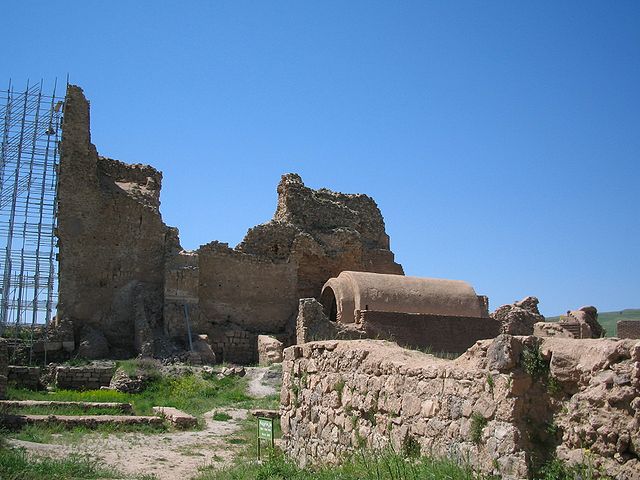
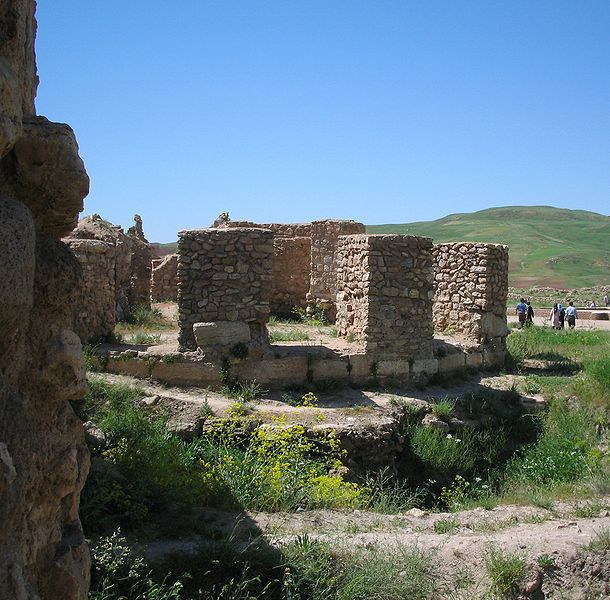
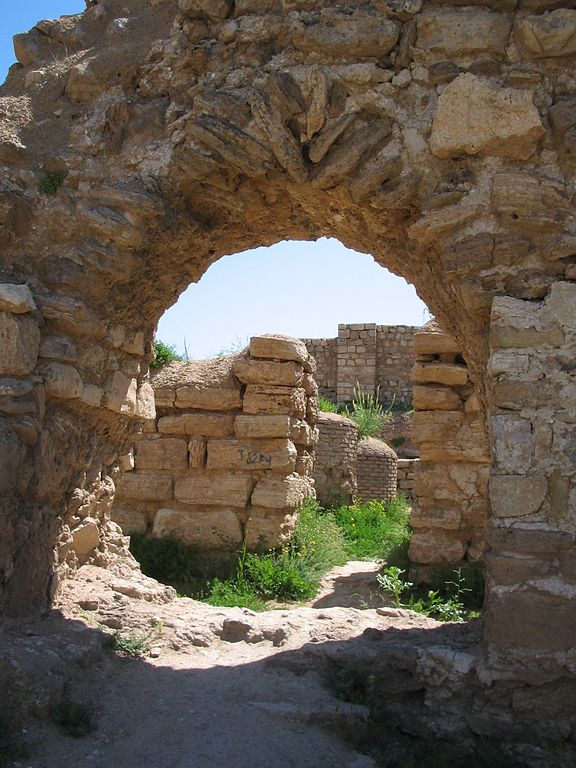
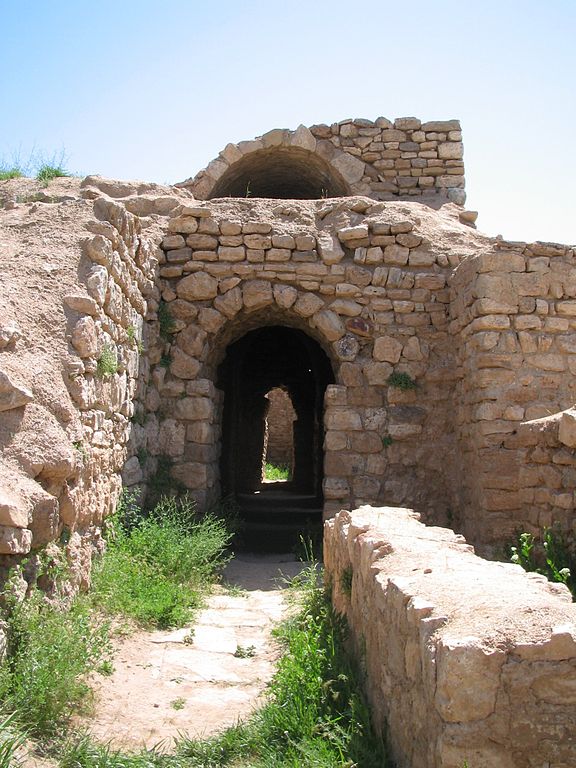
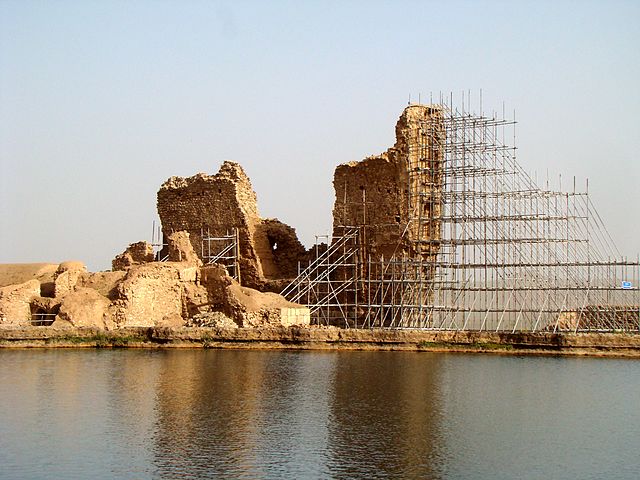
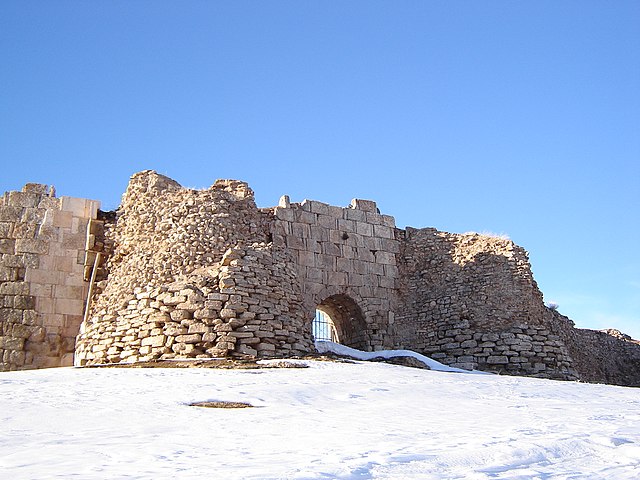
Ruins
of Takht-e-Soleyman's gate
Source
:
https://en.wikipedia.org








